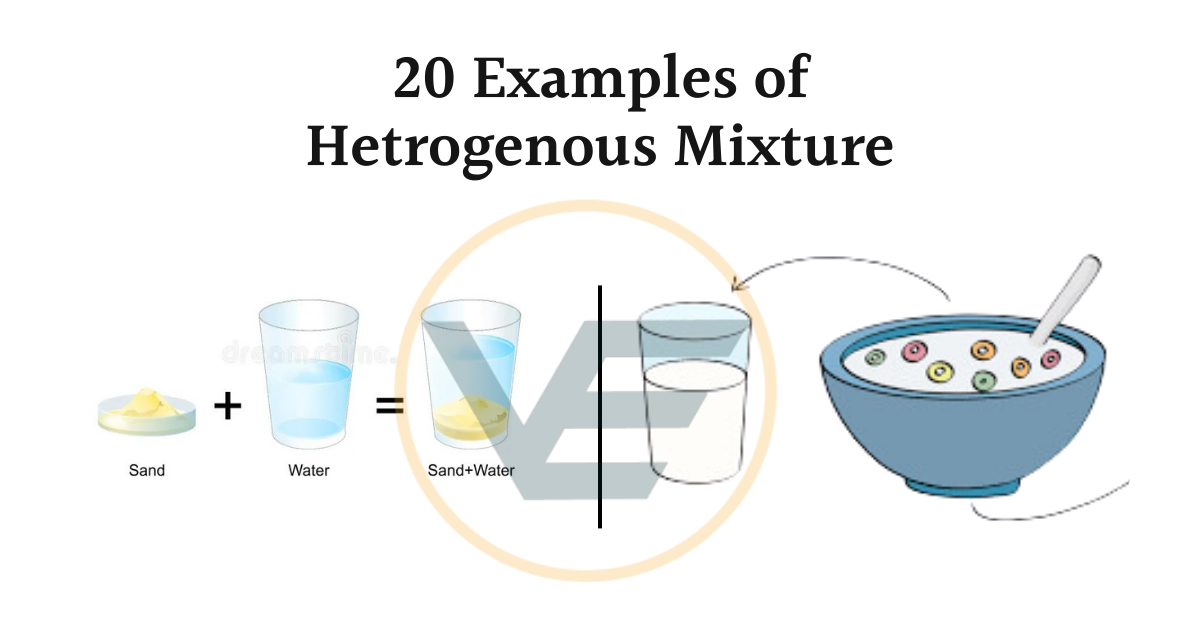Heterogeneous mixtures are a fundamental concept in chemistry and materials science, featuring visibly distinct substances. Understanding these mixtures is vital across various fields, from environmental science to industrial processes. This article delves into 20 examples of heterogeneous mixtures, showcasing their diverse nature and real-world applications.
Definition of Heterogeneous Mixtures
Heterogeneous mixtures possess non-uniform compositions, keeping different components separate and visible. Their varying properties create observable distinctions. Examples include mixtures of solids and liquids or suspensions of solids in gases or liquids. Filtration and centrifugation help study and separate these mixtures.
Examples of Heterogeneous Mixtures
Examples of Heterogeneous Mixture are given below:
Sand and Water
Description: Sand and water form a classic heterogeneous mixture. Sand particles settle at the container’s bottom, while water remains on top. Decantation or filtration easily separates them.
Oil and Water
Description: Oil and water don’t mix, creating a visible separation. Oil floats due to its lower density, making spill cleanup processes efficient.
Salad
Description: Tossed salads showcase a heterogeneous mixture of various vegetables, fruits, and toppings, maintaining individual characteristics.
Soil
Description: Soil is a complex heterogeneous mixture comprising minerals, organic matter, water, and air, influencing plant growth and agriculture.
Trail Mix
Description: Trail mix combines nuts, dried fruits, and candies, each component retaining its identity for diverse flavors and textures.
Italian Salad Dressing
Description: This dressing exemplifies a heterogeneous mixture of oil, vinegar, herbs, and spices, creating a visually distinct blend.
Orange Juice with Pulp
Description: Orange juice with pulp showcases a mixture of liquid and small pulp pieces that settle over time.
Fruit Yogurt
Description: Fruit yogurt combines yogurt and fruit pieces, allowing distinct visuals and flavors.
Cereal in Milk
Description: Adding cereal to milk results in a heterogeneous mixture, retaining cereal’s crunchiness for a delightful breakfast option.
Granite
Description: Granite, a rock with a heterogeneous mixture of minerals like feldspar, quartz, and mica, exhibits a unique speckled appearance.
Muddy Water
Description: Muddy water involves a mixture of soil particles and water, with soil settling if undisturbed.
Concrete
Description: Concrete, a versatile construction material, comprises cement, aggregates, and water in a heterogeneous blend.
Saltwater
Description: Seawater contains dissolved salts dispersed throughout the water, giving it a characteristic saline taste.

Chocolates with Nuts
Description: Chocolates with nuts maintain separate identities, offering a crunchy element in the smooth chocolate.
Vegetable Soup
Description: Vegetable soup combines various vegetables and broth, preserving distinct flavors and appearances.
Smog
Description: Smog, a heterogeneous mixture of fog and pollutants, creates visible haze in polluted urban areas.
Blood
Description: Blood, a heterogeneous mixture of cells, plasma, and platelets, performs vital functions in the human body.
Ocean Water
Description: Ocean water, with dissolved salts and marine life, exhibits varying compositions based on location and depth.
Concrete Mixture
Description: The concrete mixture involves cement, sand, gravel, and water, forming a solid structure when set.
Silt in River Water
Description: River water contains silt, a heterogeneous mixture of fine soil particles and water, contributing to soil fertility.

